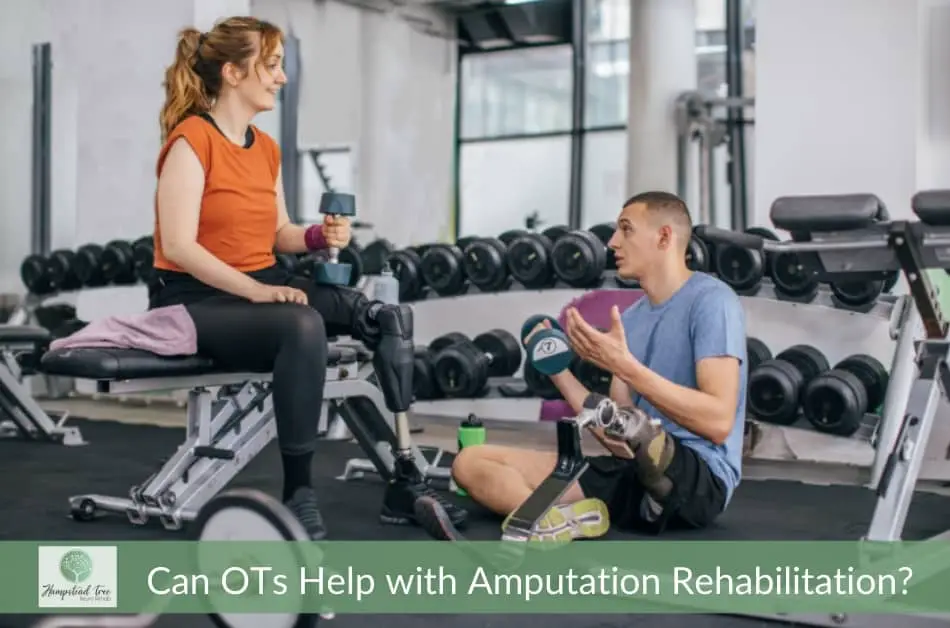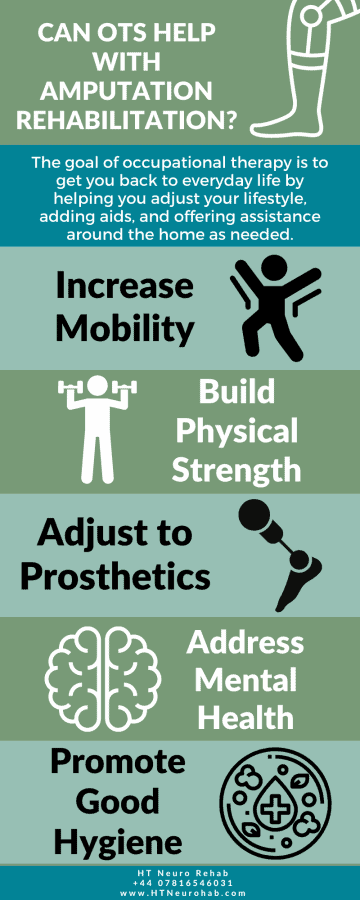
Recovering from an amputation can be a long, arduous process best approached with an organized physical and mental therapy program. Occupational therapists receive training that enables them to assist the rest of the recovery team in implementing a full-fledged rehabilitation plan.
Occupational therapists can apply their expertise to amputation recovery. The National Health Service (NHS) encourages an occupational therapy plan as an instrumental part of a combined effort to return a sense of independence to the patient. Included are enhancements for mobility around the home.
Research has shown that amputation rehabilitation programs can successfully deliver a renewed sense of independence for patients; below, we will discuss how an occupational therapist can help you or your loved one through the process.
Starting Amputation Rehabilitation with OTs
After receiving an amputation, you will be referred to a physiotherapist who will teach you how to use your prosthetic limb; this may involve learning how to walk with a prosthetic leg or grip with a prosthetic hand. The physiotherapist will also provide you with help to prevent blood clots and improve the blood supply while recovering in the hospital (Source: NHS).
Then, an occupational therapist (OT) comes into the picture. Even before you leave the hospital, you will be able to arrange a meeting with an occupational therapist to discuss what further steps may be necessary for you to enjoy the comfort of your own home.
The rehabilitation program itself can begin as quickly as a few days after the operation or as soon as the doctor approves. If your doctor has determined that you are in suitable shape for a prosthesis, it may be several months before you are fitted with a prosthetic limb. All patients are encouraged to participate in a physical assessment to decide the best path to an enhanced quality of life.
As part of the physical assessment, the OT can visit your place of residence to see if the home needs to be adapted to make it more accessible for you in the wake of your recent surgery. This is because:
- Having one limb amputated will cause you to put excess strain on the remaining appendages.
- You will need to learn how to perform daily functions like cooking, cleaning, and bathing.
- Your home may need to be converted to some degree to ensure a comfortable living space after the surgery.
Ways OTs Help Amputation Rehabilitation
An occupational therapy program can help amputees enhance several facets of life following surgery this impactful. The program will usually focus on:
- Mobility needs
- Building back physical strength
- Getting the patient comfortable with their prosthetic and the mental health impacts of the surgery
The goal of occupational therapy is to get you back to everyday life by helping you adjust your lifestyle, adding aids, and offering assistance around the home as needed. Eventually, and with time, with occupational therapy, patients should be able to comfortably manage on their own.
Increase Mobility
Decreased mobility is bound to be a side-effect of amputation surgery. Patients can have trouble performing daily tasks around the home, such as using the toilet, bathing, cooking, and cleaning.
Occupational therapists are well-versed in the realm of mobility aids for those who have recently undergone amputation surgery.
Equipment that OTs use for a smoother transition back to life at home can include:- Toileting and bathing equipment
- Special seating arrangements
- Bedding assistance, among other mobility aids
They will also look at the home environment’s infrastructure to ensure that fall hazards are identified and properly addressed. For example, a stairway may be fixed with a special railing that can help prevent future falling events. The objective here would be to provide the patient with access to as much of their home as possible without any extra help.
Build Physical Strength
Upon the completion of the surgery, patients may notice a significant reduction in overall strength. It can be difficult-to-near impossible to perform simple tasks like getting out of bed in the morning. This is where your occupational therapist comes in, with a simple exercise plan that can build back strength without leading to further strain.
The first exercises you perform in the hospital will be basic exercises that you can do while sitting or lying down. Onwards from there, “transfer techniques” will be emphasized so that you will eventually be able to get up out of bed without requiring further assistance; this will be especially important when you return home so that you can leave the bed of your own volition.
These exercise programs operate on a patient-by-patient basis. Having your own personalized exercise plan ensures that you do not further harm yourself because you are putting excess strain on your other arms or legs; this is a common issue that arises as amputees work to adjust their range of motion.
Adjust to Prosthetics
Some amputation patients may desire or require a prosthetic to replace a limb. However, not all patients will be eligible for one. A physical condition assessment performed by the doctor(s) and medical staff will determine whether you qualify.
If you end up using a prosthetic, your occupational therapist will assist you with the learning process and ensuring you’re comfortable with it.
For example, in the event of a lower limb prosthesis, a piece of equipment called a “stump board” may be provided; the occupational therapist will teach you everything you need to know about the device so that you’re able to handle using and attaching/removing it on your own.

Address Mental Health
Losing a limb can have a significant psychological impact on the patient. Many patients report feeling a sense of loss and a newfound sense of body image. Some patients suffer from occasional phantom pain at the location where the removed limb used to be.
Occupational therapy offers faith in a path forward, starting with treatment for any phantom pain that the patient is reporting. Compression garments have been shown to reduce swelling at the surgery site and even help minimize phantom pain, per the National Health Service (NHS).
An occupational therapist will also be ready to tackle the other psychological impacts associated with this surgery, including social skills and community skills. An occupational therapist will also refer either you or a loved one to a qualified specialist if they feel that this is necessary.
Promote Good Hygiene
Teaching patients how to keep the site of the amputation clean is also an emphasis of occupational therapy. This includes training the patient on how to use, change, and clean any bandages and the compression sock.
The amputation site will be a hazard for infection in the early stages. The occupational therapist will help ensure that infections do not occur, particularly when the patient is out of the hospital and in their home environment.
In Summary
Occupational therapy plays a pivotal role in the rehabilitation of amputees. Occupational therapists (OTs) are called upon to be quite versatile, as they are equipped to tackle the physical and psychological impacts of a recent amputation procedure on patients.
Ultimately, occupational therapy is known to offer plenty of benefits when used for amputation rehabilitation, including for those recovering after lower limb transplants. Occupational therapists can help amputees:
- Rebuild physical strength
- Learn to transfer from a bed or a chair to a wheelchair/another mobility device
- Make the necessary adjustments to a living space to remove fall hazards
- Learn to perform daily tasks like cooking and cleaning
- Address any psychological impacts of the surgery
- Learn how to keep the amputation site on the body clean and free of infection
- Have the means to enhance quality of life after the amputation
Content Disclaimer
The information contained above is provided for information purposes only. The contents of this Blog article are not intended to amount to advice, and you should not rely on any of the contents of this Blog article. Professional advice should be obtained before taking or refraining from taking any action as a result of the contents of this Blog article. OccupationaltherapyBlog disclaims all liability and responsibility arising from any reliance placed on any of the contents of this Blog article.

